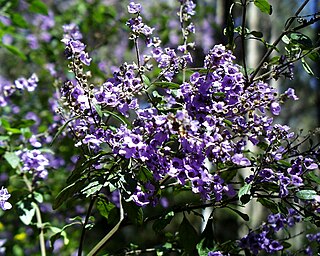
Prostanthera melissifolia, commonly known as balm mint bush, is a species of flowering plant in the family Lamiaceae and is endemic to south-eastern Australia. It is an erect shrub with hairy branches, egg-shaped leaves with fine teeth on the edges and mauve to purple or pink flowers on the ends of branchlets.

Prostanthera eurybioides, commonly known as Monarto mintbush, is a species of flowering plant in the family Lamiaceae and is endemic to the south-east of South Australia. It is a low, spreading shrub with densely hairy branches, thick, elliptic to egg-shaped leaves clustered on short shoots, and violet to mid-purple flowers that are white with orange and dark purple dots inside the petal tube.

Prostanthera ovalifolia, commonly known as the oval-leaf mintbush or purple mintbush, is a species of flowering plant in the family Lamiaceae and is endemic to south-eastern continental Australia. It is an erect shrub with egg-shaped leaves and groups of mauve to deep blue-purple flowers arranged in groups at the ends of branchlets.

Prostanthera nivea, commonly known as snowy mint-bush, is a species of flowering plant in the family Lamiaceae and is endemic to eastern Australia. It is a shrub with linear to cylindrical leaves and white flowers arranged in leaf axils near the ends of branchlets and is one of the mint-bushes that is not aromatic.

Prostanthera phylicifolia, commonly known as spiked mint-bush, is a species of plant in the family Lamiaceae. It is an erect shrub with four-ridged branches, narrow egg-shaped to oval leaves and white or pale lilac-coloured flowers with purple and yellow spots.

Persoonia arborea, commonly known as tree geebung, is a species of large shrub or small tree that is endemic to Victoria, Australia.

Prostanthera stenophylla is a species of flowering plant in the family Lamiaceae and is endemic to Wollemi National Park in New South Wales. It is an erect, slender, aromatic shrub with hairy, oblong leaves and small groups of pale bluish mauve to violet flowers.

Prostanthera walteri, commonly known as blotchy mint-bush, is a species of flowering plant that is endemic to south-eastern Australia. It is a sprawling shrub with tangled, hairy branches, egg-shaped leaves and usually bluish green flowers with prominent purple veins arranged singly in leaf axils.
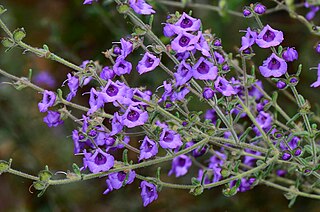
Prostanthera hirtula, commonly known as hairy mintbush, is a species of flowering plant in the family Lamiaceae and is endemic to the south-eastern continental Australia. It is a strongly aromatic, densely hairy, spreading shrub with narrow egg-shaped leaves and dark mauve flowers, and that grows in exposed, rocky sites.
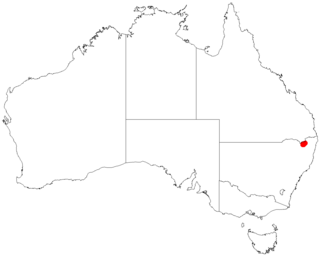
Prostanthera staurophylla, commonly known as Tenterfield mint-bush, is a species of flowering plant in the family Lamiaceae and is endemic to a small area on the New England Tableland of New South Wales. It is an erect to spreading, strongly aromatic shrub with hairy branches, deeply lobed leaves and bluish-mauve flowers with darker markings.

Prostanthera prostantheroides is a plant in the family Lamiaceae and is endemic to Western Australia. It is a shrub with heart-shaped to round leaves and usually white flowers with purple spots inside the petal tube.
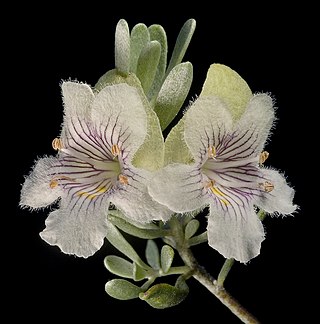
Prostanthera althoferi is a species of flowering plant in the family Lamiaceae and is endemic to inland areas of Australia. It is an erect shrub with its stems and leaves densely covered with silvery, greyish-green hairs, and has narrow egg-shaped leaves and white to cream-coloured flowers with mauve or purple striations inside.
Prostanthera athertoniana is a species of flowering plant in the family Lamiaceae and is endemic to a restricted area of Queensland. It is a small, densely-foliaged shrub with strongly aromatic, elliptical, oblong or egg-shaped leaves and hairy, purplish-mauve flowers arranged singly in upper leaf axils.

Prostanthera canaliculata is a species of flowering plant in the family Lamiaceae and is endemic to the south-west of Western Australia. It is a small, erect shrub with hairy branchlets, narrow egg-shaped to narrow elliptical leaves and pale blue or pale violet to white flowers with no markings.

Prostanthera eckersleyana, commonly known as crinkly mintbush, is a species of flowering plant in the family Lamiaceae and is endemic to the south-west of Western Australia. It is an erect or spreading shrub with sticky, hairy branchlets, egg-shaped to elliptical leaves and blue, mauve to purple or violet flowers with maroon spots inside the petal tube.

Prostanthera eungella is a species of flowering plant in the family Lamiaceae and is endemic to the Eungella region in Queensland. It is an erect shrub with narrow egg-shaped leaves with small teeth, and mauve flowers that are white inside the petal tube and arranged in upper leaf axils.
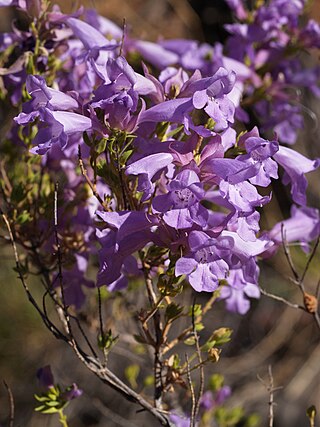
Prostanthera ferricola is a species of flowering plant in the family Lamiaceae and is endemic to central Western Australia. It is an erect, openly branched shrub with aromatic, egg-shaped leaves and mauve-purple flowers arranged in four to twelve leaf axils near the end of branchlets.
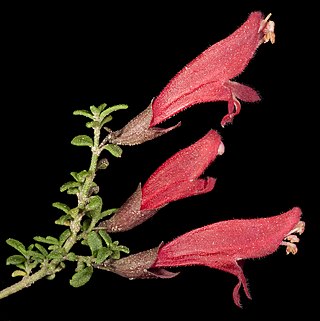
Prostanthera grylloana is a species of flowering plant in the family Lamiaceae and is endemic to Western Australia. It is a small, erect shrub with densely hairy branchlets, small, spatula-shaped leaves and red to pink flowers.

Prostanthera scutata is a species of flowering plant in the family Lamiaceae and is endemic to Western Australia. It is a small, erect, compact shrub with densely hairy branches, elliptic to narrow elliptic leaves and pale blue or faintly violet flowers.

Prostanthera wilkieana is a species of flowering plant that is endemic to the more arid areas of Australia. It is an erect, densely-branched shrub with elliptic to narrow egg-shaped leaves with the narrower end towards the base and mauve to pale violet or white flowers with deep purple streaks and yellowish brown dots inside the petal tube.




















